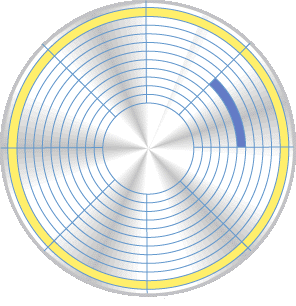Storing the Data
Data is stored on the surface of a platter in sectors and tracks . Tracks are concentric circles, and sectors are pie-shaped wedges on a track, like this:
 |
A typical track is shown in yellow; a typical sector is shown in blue. A sector contains a fixed number of bytes -- for example, 256 or 512. Either at the drive or the operating system level, sectors are often grouped together into clusters .
The process of low-level formatting a drive establishes the tracks and sectors on the platter. The starting and ending points of each sector are written onto the platter. This process prepares the drive to hold blocks of bytes. High-level formatting then writes the file-storage structures, like the file-allocation table, into the sectors. This process prepares the drive to hold files.
Back to How It Works
› Introduction to How Hard Disks Work
› Hard Disk Basics
› Inside a Hard Disk
› Storing the Data